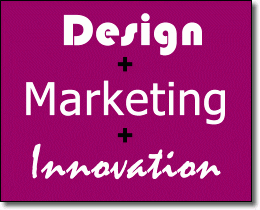By: Chuck Frey
Over recent years the terms innovation and design thinking have taken on a life of their own through a variety of channels and media. Millions of words have been written on these topics by journalists, consultants, practitioners, and curious bystanders. Then throw in discussions about design itself and an even wider range of opinions emerge. What is a business leader supposed to make of all of this?
Years ago and much earlier than the current hype cycle, Peter Drucker wrote that the two main functions of a business are marketing and innovation. Drucker did a superb job defining both areas. Over the past 30 years, many business leaders seemed to have forgotten that their purpose as a business is to get customers and not focusing on cost-cutting, off-shoring jobs and maximizing shareholder value.
To my mind, marketing and design both share the same business objective. That objective is to find customer problems and solve them with new offerings. A positive result of the renewed focus on innovation has shown that anything new (not just products or services alone) that generates economic value can generate growth and increased customer value. New business models, processes or partnerships, product or service platforms, channels, brands, or customer experiences can all generate new economic value.
Business leaders must decide how to throttle their innovation efforts, from incremental to transformational in order to direct the future vision and strategic intent of the organization. Innovation is a result. Achieving innovation requires a combination of user research, competitor research, and market driver research (i.e. social, technical, economic, environmental, and political/legal evolutions) and analysis of these elements to make sense of the customers’ world and then creatively solve the challenges people have while operating in these worlds.
Effective solution development and delivery requires the skills and talents of both marketers and designers, not to mention engineers, accountants, and customer service people as well. It is marketing and design people, though who should be on the leading edge of opportunity discovery and customer problem framing. Just as strategic marketing is more than just messaging, strategic design is more than just making things look good.
A key strength of marketing is to understand customers and markets, and some key strengths of design are to look at the customers’ world differently, to break out of constraining biases, and to invent the future. A high level integration of these two disciplines should make any company stronger and more effective over the long haul.
Creating an organizational future requires the combination of both marketing and design skills in order to deliver innovation.
The concept of “design thinking” seeks to merge the creativity of the designer with the realities of the market. While I both appreciate and dislike this phrase at the same time, so far it is the best description available to help business leaders see that creating an organizational future requires the combination of both marketing and design skills in order to deliver innovation.
“Thinking” like a designer, or taking a design approach, extends research and analysis toward experimenting with a variety of concepts in order to create desirable, feasible and viable new solutions. Taking this type of approach combines critical thinking and systems thinking in order to invent a future state. Imbedding this approach into the marketing function will help create a future state that breaks free of current reality and discovers “what could be”.
Another positive result of all this discussion is there appears to be a change underway in business education. Design approaches for discovering and meeting customer opportunities are increasingly showing up in MBA programs. This is very exciting because a wider range of people are gaining insight into how marketing and design can be blended together to not only improve on products and services, but to make the lives of their customers better. This blend of skills can find new ways of improving customer experiences; from the way people are attracted to a company, through the occasion of use, to an extended relationship using new digital approaches.
The Design Management Institute’s LinkedIn group has highlighted discussions recently on design’s value to the organization, where design ought to reside in an organization, and how design could work more effectively within marketing groups. There appears to be strong potential for merging these two disciplines together at a strategic level. Marketing and design both have the objective of meeting the customers’ needs, and both can support the business’ strategic intent and drive toward achieving sustainable competitive advantage.
There are tactical challenges in linking marketing and design more closely together, especially with so many specialties existing within each domain. Marketing groups include advertising, public relations, event planning, channel management, etc. Design consists of industrial design, graphic design, packaging design, web design, systems design, etc. Product management and product marketing also exist in many organizations separately from corporate marketing. Depending on the size and type of company, design may also exist as a separate department as well.
There are many different political agendas within individual companies, and all of this makes for a very challenging organizational design effort. One of the biggest self-inflicted obstacles in many companies is that people at the tactical levels of an organization have been trying to push a strategic change from the bottom-up. Just as the CEO of a business needs to be the key driver in developing an effective innovation process and culture, it is the CEO who needs to see the strategic side of design and learn to incorporate that value with marketing and create a new type of marketing organization.
This type of organization would be much more in line with Drucker’s view of a business, and could help companies create more useful offerings, business models, and processes. It could help lead organizations to be more socially relevant and environmentally sound. Design and marketing should be closely tied together to ensure the delivery of innovation to the market. It only makes sense to have them working more closely to achieve the strategic intent of a business, and conversely, to help develop strategic alternatives that can affect the evolution of strategic intent. All that is needed is getting the CEO to take the lead.
About the author
Chuck Frey Senior Editor, founded InnovationTools.com and served as its publisher from its launch in 2002 until the partnership with Innovation Management in 2012. He is the publisher of The Mind Mapping Software Blog, the definitive souce for news, trends, tips and best practices for visual mapping tools. A journalist by trade, Chuck has over 14 years of experience in online marketing, and over 10 years experience in business-to-business public relations. His interests include creative problem solving, visual thinking, photography, business strategy and technology. His unique combination of experience and influences enables him to envision new possibilities and opportunities.
Senior Editor, founded InnovationTools.com and served as its publisher from its launch in 2002 until the partnership with Innovation Management in 2012. He is the publisher of The Mind Mapping Software Blog, the definitive souce for news, trends, tips and best practices for visual mapping tools. A journalist by trade, Chuck has over 14 years of experience in online marketing, and over 10 years experience in business-to-business public relations. His interests include creative problem solving, visual thinking, photography, business strategy and technology. His unique combination of experience and influences enables him to envision new possibilities and opportunities.

